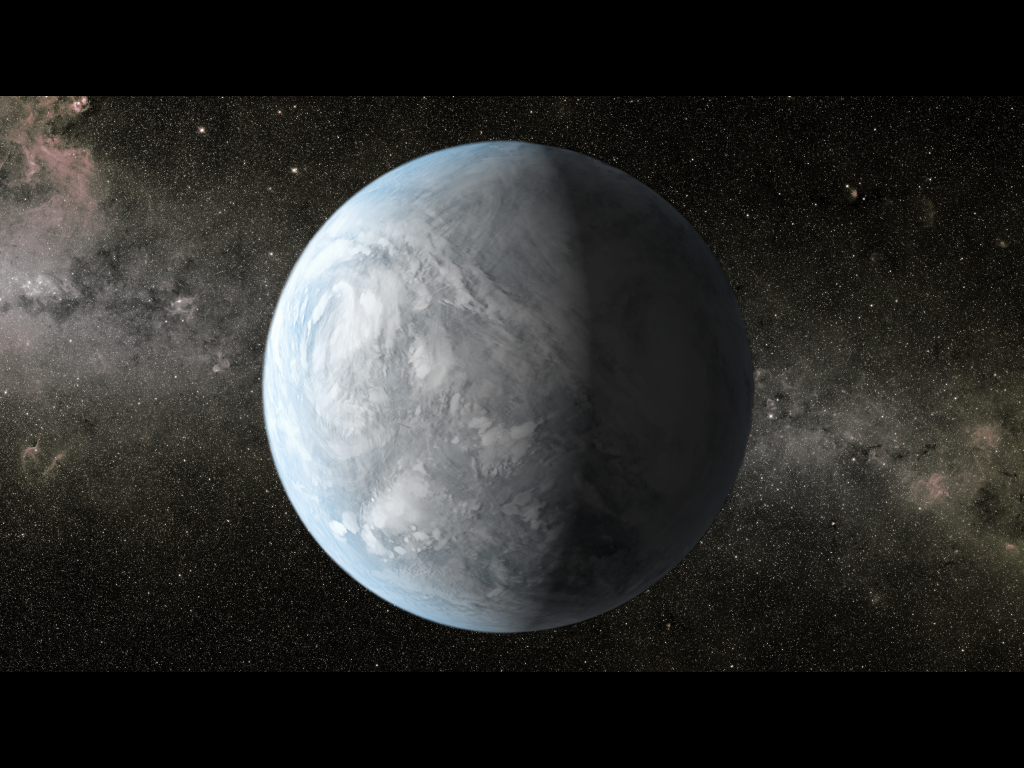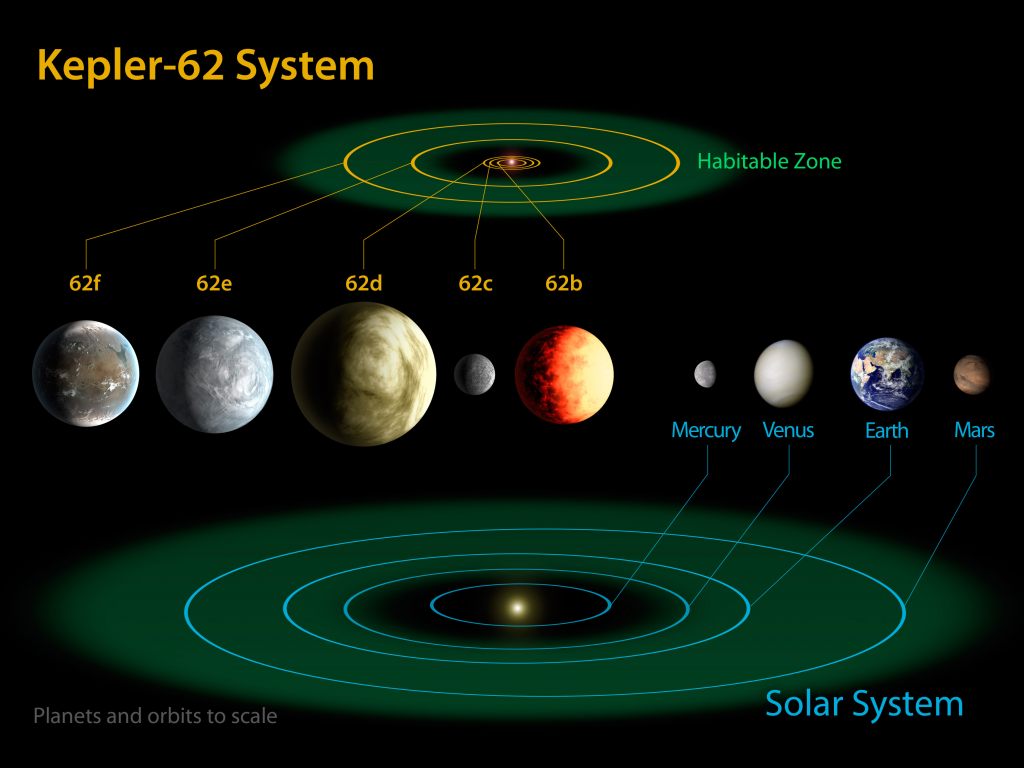Kepler-62e: Super-Earth & Possible Water World

Kepler-62e is an exoplanet believed to be a water world, orbiting at about the equivalent distance of Mercury in its planetary system some 1,200 light-years from Earth. The planet is an exciting find to exoplanet researchers because it is close in size to Earth, and also orbits in the habitable region of its star (which is smaller and dimmer than that of Earth's).
The planet is about 1.6 times the size of Earth and orbits its parent red dwarf star about once every 122 days. It is actually one of two possibly habitable planets in its system. Also present, but farther out from the star, is Kepler-62f, which is about 1.4 times the size of Earth.
Taken together, the two planets "look very good as possibilities for looking for life," said Kepler science principal investigator Bill Borucki, of NASA's Ames Research Center in Moffett Field, Calif., in a press conference announcing seven new planets (including these two) in 2013.
The world is classified as a "super-Earth," meaning that it likely has similar characteristics to our own planet but that it is larger than our world. A modeling study, performed separately, also concluded that Kepler-62e and Kepler-62f are likely covered mostly — perhaps completely — in water.
"Kepler-62e probably has a very cloudy sky and is warm and humid all the way to the polar regions," modeling co-author Dimitar Sasselov of Harvard University stated. "Kepler-62f would be cooler, but still potentially life-friendly."
Civilization would be difficult
Kepler-62e is one of thousands of exoplanet candidates discovered by the Kepler space telescope, whose primary mission is to seek out exoplanets (especially Earth-like ones) outside of the solar system. [Infographic: NASA's Planet-Hunting Kepler Telescope Explained]
Kepler-62e and Kepler-62f are two of five potential planets discovered in the Kepler-62 system. At the same time, researchers also disclosed two planetary candidates in Kepler-69, including another super-Earth called Kepler-69c.
Breaking space news, the latest updates on rocket launches, skywatching events and more!
The hypothesis that Kepler-62e is a water world would perhaps make civilization more difficult to achieve, at least by our own understanding. There could still be fairly advanced organisms lurking in the water, Borucki added in a 2013 interview.
"At least in our ocean, we have flying fish. They 'fly' to get away from predators," Borucki said. "So we might find that they have evolved — birds — on this ocean planet."
The modeling study suggests that Kepler-62e would have a very hospitable climate for life, as it would be a damp and warm environment even up to the area around its poles.
"Look at our own ocean — it is just absolutely full of life," said Borucki, who also led the team that discovered Kepler-62e and Kepler-62f. "We think, in fact, life [on Earth] might have begun there."
At the time, researchers added the discovery of the two water worlds pointed to the possibility of finding a planet like Earth in the near future. "I think we're making excellent progress in that direction," said Borucki. "We have a number of candidates that look good."
The planets are quite distant from Earth, but as researchers edge closer to finding an Earth 2.0, some scientists speculated that these finds could spur travel that could move faster than the methods that we have available today. [Countdown: 7 Greatest Alien Planet Discoveries by NASA's Kepler Spacecraft (So Far)]
"Imagine looking through a telescope to see another world with life just a few million miles from your own. Or, having the capability to travel between them on a regular basis. I can't think of a more powerful motivation to become a space-faring society," stated Sasselov.
Further studies
Since its initial discovery, most of the papers concerning Kepler-62e have been talking about the limits of habitability, or discussing its possible formation history.
A 2015 paper in Astronomy & Astrophysics discussed the effects of tides in Kepler-62's planetary system based on simulations. The authors wrote that the four inner planets likely have slow rotation rates and low obliquity (referring to the tilt between the axis of the planet, and its orbit). The fifth planet would have a fast rotation rate and high obliquity.
"This means that the two habitable zone planets of this system, Kepler-62e and f, are likely to have very different climate features, and this of course would influence their potential at hosting surface liquid water," the authors wrote in the abstract.
Kepler-62e was also chosen as a "test case" to figure out the temperature of Earth-like planets in a 2015 paper published in the Astrophysical Journal. The authors tested a new model and discovered uncertainties in measuring the surface pressure of the planet can impact the average temperature by about 60 Kelvin (minus 351.7 degrees Fahrenheit or minus 213.1 degrees Celsius). This would also have implications for the habitability.
A 2014 paper in the International Journal of Astrobiology discussed the possibility of a moon around Kepler-62e. Simulations suggest that the planet would have to be made of iron and dissipate its tides only by a certain amount to allow for its moon to last five billion years or longer, similar to the Earth's system. "Large moons stabilize planetary obliquity in some cases, and it has been suggested that large moons are necessary for the evolution of complex life," the authors wrote in the abstract.

Elizabeth Howell (she/her), Ph.D., was a staff writer in the spaceflight channel between 2022 and 2024 specializing in Canadian space news. She was contributing writer for Space.com for 10 years from 2012 to 2024. Elizabeth's reporting includes multiple exclusives with the White House, leading world coverage about a lost-and-found space tomato on the International Space Station, witnessing five human spaceflight launches on two continents, flying parabolic, working inside a spacesuit, and participating in a simulated Mars mission. Her latest book, "Why Am I Taller?" (ECW Press, 2022) is co-written with astronaut Dave Williams.

